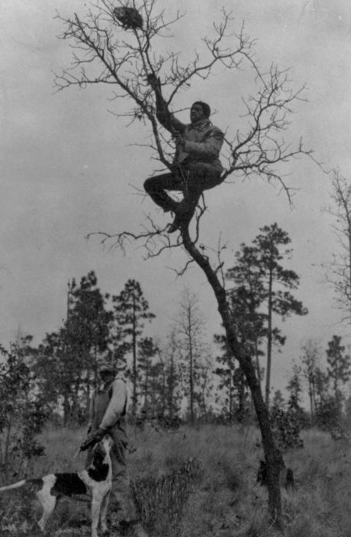All who have studied the history of Four Oaks, are aware that it was named by Colonel Robert Rufus Bridgers, President of the Wilmington and Weldon Railroad. A supply depot, to accommodate the work train that built the “shortcut” from Smithfield to Benson in 1885, was established on the south side of the tract. Colonel Bridgers immediately noticed the oddity of an oak tree that had been cut down but had sprouted out into four trees of their own from the same stump. The tree was located in Barbour’s Grove, the homeplace of Kinchen Barbour and his family. The four oaks tree stood directly in the front of the Barbour house.
The tree in question was a victim of a ‘possum hunt, according to local lore, sometime in the 1850s. Aaron Wallace was the man that on a fateful night would tree a ‘possum in the future Four Oaks oak. Wallace most likely treed the ‘possum using hound dogs that ran the creature up the tree. Why cut down the tree? ‘Possums could not be shot out of the tree and killed during the hunt. ‘Possums were known to eat anything and everything including poison that would not kill the ‘possum but could have an effect on the eater. So, ‘possums had to be caught live, thrown in a toe sack and carried home. Before you could carry it home though, you had to get to it, hence down came the tree. The ‘possum was penned and fed greens to help clean it out and in time it was cooked for the table. Although, ‘possum is greasy, just look at the road next time you pass one, it supplemented the table of the poor more often than not.
Aaron Wallace was born about 1815 in the vicinity of present-day Four Oaks. In 1837, he married Nancy Stanley, with whom he would have 9 children between 1837 and 1858. Aaron was an individual who lived by his trade, a cooper. Coopers produced wooden products such as barrels, buckets, piggins, and other things made of wood. It was hard work that caused arthritis to set up in the hands early that were always callous. As a cooper, his talent was needed in the Four Oaks area, he produced the barrels for Naval Stores. Naval Stores was big business in the Four Oaks area due to the large amount of longleaf pine trees that grew in the area. The products of Naval Stores were tar, pitch, turpentine, spirits of turpentine, and resin, which all had to be transported in barrels. The products of the pine tree were sold in large part to the United States Navy to keep their wooden-hulled ships afloat.
The Federal Census provides the best snapshot and insight into the life of Aaron Wallace. By the time of the 1850 Census, Aaron was living and working in the new village of Bentonsville, which had started in the late 1840s. Bentonsville leading citizen of that day was Lawrence Peacock, who had a mercantile, turpentine distillery and performed the duties of Postmaster for the new Post Office established in his store. A number of support people resided in the village as tradesmen to produce such things as barrels for the distillery such as Wallace. The family lived in a rented house as Wallace listed no real estate values on the Census. (Part 1 of 2)
Story by Ray King
